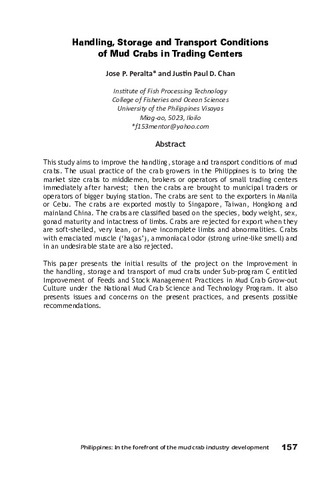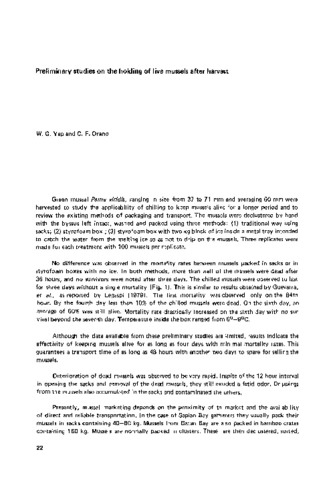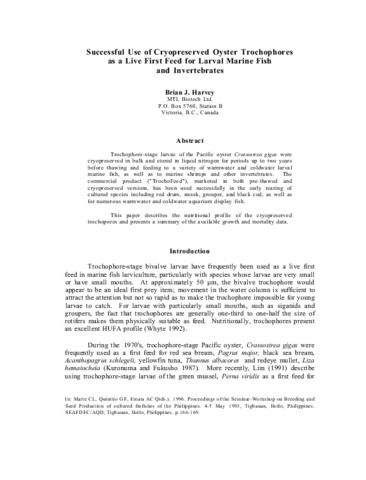Handling, storage and transport conditions of mud crabs in trading centers
- Global styles
- MLA
- Vancouver
- Elsevier - Harvard
- APA
- Help
Share
抄録
This study aims to improve the handling, storage and transport conditions of mud crabs. The usual practice of the crab growers in the Philippines is to bring the market size crabs to middlemen, brokers or operators of small trading centers immediately after harvest; then the crabs are brought to municipal traders or operators of bigger buying station. The crabs are sent to the exporters in Manila or Cebu. The crabs are exported mostly to Singapore, Taiwan, Hongkong and mainland China. The crabs are classified based on the species, body weight, sex, gonad maturity and intactness of limbs. Crabs are rejected for export when they are soft-shelled, very lean, or have incomplete limbs and abnormalities. Crabs with emaciated muscle (‘hagas’), ammoniacal odor (strong urine-like smell) and in an undesirable state are also rejected.This paper presents the initial results of the project on the Improvement in the handling, storage and transport of mud crabs under Sub-program C entitled Improvement of Feeds and Stock Management Practices in Mud Crab Grow-out Culture under the National Mud Crab Science and Technology Program. It also presents issues and concerns on the present practices, and presents possible recommendations.
記述
Abstract only.
Suggested Citation
Peralta, J. P., & Chan, J. P. D. (2017). Handling, storage and transport conditions of mud crabs in trading centers. In E. T. Quinitio, F. D. Parado-Estepa, & R. M. Coloso (Eds.), Philippines : In the forefront of the mud crab industry development : proceedings of the 1st National Mud Crab Congress, 16-18 November 2015, Iloilo City, Philippines (p. 157). Tigbauan, Iloilo, Philippines: Aquaculture Department, Southeast Asian Fisheries Development Center.
Type
Conference paperISBN
9789719931072Collections
Related items
Showing items related by title, author, creator and subject.
-
Preliminary studies on the holding of live mussels after harvest
Yap, Wilfredo G.; Orano, C. F. (Aquaculture Department, Southeast Asian Fisheries Development Center, 1980)Green mussel (Perna viridis) were harvested to study the applicability of chilling to keep the mussels alive for a longer period of time and to review existing methods of packaging and transport. Data obtained from preliminary ... -
Defects in the handling, storage and transport of mud crab
Peralta, Jose P.; Cheung, Dominique S. (Aquaculture Department, Southeast Asian Fisheries Development Center, 2017)Consumers prefer to buy live mud crabs (Scylla). Moribund and dead crabs have very low market value. Immediately after harvest, the crabs are tied to render their claws immobile. The time between harvest and arrival of ... -
Successful use of cryopreserved oyster trocophores as a live first feed larval marine fish and invertebrates
Harvey, Brian J. (Aquaculture Department, Southeast Asian Fisheries Development Center, 1996)Trochophore-stage larvae of the Pacific oyster Crassostrea gigas were cryopreserved in bulk and stored in liquid nitrogen for periods up to two years before thawing and feeding to a variety of warmwater and coldwater larval ...






